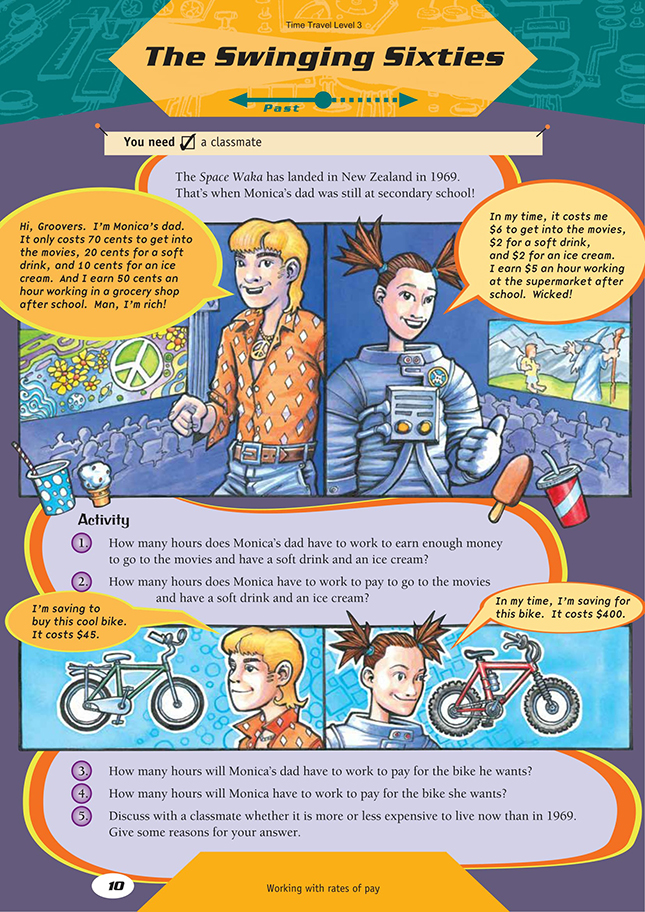This is a level 3 number activity from the Figure It Out theme series.
A PDF of the student activity is included.
Click on the image to enlarge it. Click again to close. Download PDF (360 KB)
use addition, subtraction, multiplication and division to solve problems involving rates of pay
FIO, Level 3, Theme: Time Travel, The Swinging Sixties, page 10
A classmate
In this activity, the students perform calculations within the context of money and rates of pay and compare the cost of living now with that in the sixties.
The concept of pay rates in dollars per hour may be unfamiliar to students. Discuss this concept with the students.
After the students have read Monica’s and her dad’s statements in the speech bubbles at the top of the page, you could ask them question 5, that is, “Is it more or less expensive to live now?” They can compare this initial response to their response after they have completed the other questions.
Make sure that the students understand that how much Monica and her dad earn per hour is not the only thing they need to take into account. The students need to work out what Monica and her dad can buy for that amount of money. Some students might leap to the conclusion that Monica is a lot better off than her dad because she earns 10 times more, but the students need to understand that she can’t actually buy 10 times more, and her buying power isn’t very different from her dad’s.
Students will need to perform two steps in their calculations to solve questions 1 and 2. First, they need to calculate the cost of a visit to the movies, an ice cream, and a soft drink. The students then need to calculate how many hours Monica and her dad will need to work to earn this amount of money.
The students may use a range of strategies to solve questions 3 and 4. The three strategies shown below are arranged in increasing levels of complexity.
• Additive strategy
50c + 50c = $1 so that’s 2 hours’ work for Monica’s dad.
To earn $5: 2 hours + 2 hours + 2 hours + 2 hours + 2 hours = 10 hours’ work.
So at 10 hours for every $5: $5 + $5 + $5 + $5 + $5 + $5 + $5 + $5 + $5 = $45
= 10 hours + 10 hours + 10 hours + 10 hours + 10 hours + 10 hours + 10 hours + 10 hours + 10 hours = 90 hours’ work.
If students use this strategy, you could point out the link between multiplication and repeated addition and that multiplication is more efficient.
• Multiplicative strategy
If Monica’s dad earned $1 an hour, it would take him 45 hours to earn enough to buy the $45 bike.
Doubling 50 cents (x 2) gives us $1.
If we double the money amount, we also need to double the time, so 45 x 2 = 90 hours’ work.
• Division strategy
Using known facts for question 4:
$400 at $5 per hour = 400 ÷ 5 hours (I know that 40 ÷ 5 = 8, so 400 ÷ 5 = 80.)
= 80 hours
Answers to Activities
1. 2 hours
2. 2 hours
3. 90 hours
4. 80 hours
5. Answers will vary, but from this information, Monica and her dad have to work for about the same length of time to get the same things, so it’s probably not any more or less expensive to live now than in 1969.
